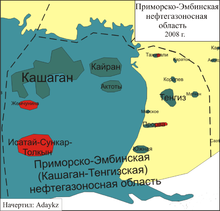Kashagan
Coordinates: 46 ° 10 ′ 0 ″ N , 51 ° 35 ′ 0 ″ E
Kashagan ( Kazakh Қашаған , Russian Кашаган ) is an oil field in Kazakhstan .
geography
The oil reserves of the Kashagan oil field - one of the last great discoveries of the past decades - are said to contain 9-16 billion barrels of recoverable oil (for comparison: in 2011 the US imported 3.261 billion barrels of crude oil or 4.198 billion barrels of crude oil and oil products). Its development represents a great financial and technical challenge, as it is offshore in a climatically rough (5 months frozen part of the Caspian Sea ) and ecologically precarious environment (including the spawning ground of the beluga sturgeon ) and in a politically unstable region.
history
The field is in the northern Caspian Sea near the city of Atyrau . It was discovered in 2000. The field is being developed by the Italian company Eni . In addition to Eni, which initially held 18.52% of the shares, Shell , Total and ExxonMobil also held 18.52%, ConocoPhillips with 9.26%, KazMunayGas with 8.33% and INPEX with 8.33%.
For these reasons, the development costs rose immensely from the initially planned 57 to 136 billion US dollars. In the summer of 2007, the development was stopped for several weeks after the Kazakh Environment Minister Nurlan Iskakov stated that relevant environmental and customs regulations had not been met. The start of production has been postponed by Eni to the end of 2012, while Kazakh officials believed 2013 or 2014 to be more likely. In 2014 it was clear that no oil could be produced before 2016. Funding was originally planned to start in 2005.
In mid-January 2008, Kazakh President Nursultan Nazarbayev invited the six foreign oil companies involved to a meeting, which was supposed to be about renegotiating Kazakhstan's profit sharing as compensation for the postponed start of production. One reason is likely to have been the sharp rise in the price of oil , which was $ 20 when the contract was signed and rose to over $ 90 by the end of 2007. Reference can also be made to “international role models” (such as Russia and Venezuela).
On January 14, 2008, the Kazakh energy minister Sauat Myngbajew announced via the Interfax news agency that Kazakhstan's state-owned oil company would double its stake to 16.81%, while the foreign partners would give up corresponding shares. Thus, all partners would each come to 16.81%. In return, the Kazakhs will have to pay their foreign partners a total of 1.2 billion euros from 2011 - a negotiation result that all partner companies including Exxon had finally agreed to.
On September 7, 2013 it was announced that the People's Republic of China had acquired an 8 percent share of the oil field for five billion US dollars. Corresponding contracts between the China National Petroleum Corporation (CNPC) and QasMunaiGas were signed in Astana. The reserves of the oil field are estimated at around 38 billion barrels (159 liters each).
12 million tons of oil were produced between January and November 2018. This was 21 percent above expectations and thus just exceeded the production from the Karachaganak gas field , which, however, also contains extremely large amounts of gas condensate and crude oil. 11.1 million tons were produced there in the same period.
However, while Tengiz remained clearly the most effective field in 2018 with 25.9 million tons for the entire year, almost a third of all Kazakh oil production in 2018. By comparison, Kazakhstan's oil exports between January and November 2018 were 66 million tons.
Web links
- Offshore North Caspian Sea Block, Republic of Kazakhstan (INPEX North Caspian Sea, Ltd.) <Discovered>. (No longer available online.) In: www.inpex.co.jp. Archived from the original on October 24, 2004 .
- Home. (No longer available online.) In: agipkco.com. Archived from the original on December 5, 2012 ; accessed on April 30, 2020 (English, Agip KCO website).
- RIGZONE - Oil & Gas Field Development Projects - Kashagan. (No longer available online.) In: www.rigzone.com. Archived from the original on September 27, 2007 .
Individual evidence
- ^ US Total Crude Oil and Products Imports. Accessed April 30, 2020 (English).
- ^ Amie Ferris-Rotman, Olzhas Auyezov: Kashagan's new operator to include all companies. reuters.com, October 7, 2008, accessed April 30, 2020 .
- ↑ Géraldine Amiel, Selina Williams: Problem oil field Kashagan will not produce before 2016. wsj.com, June 10, 2014, accessed April 30, 2020 .
- ↑ Cyrus Sanati: showdown in Kazakhstan. In: Handelsblatt. ( handelsblatt.com ).
- ↑ Hungry for energy: China joins the Kazakh oil project . In: Frankfurter Allgemeine Zeitung . ( faz.net [accessed April 30, 2020]).
- ↑ Kulpash Konyrova: Kazakhstan's oil industry Gradually Increases its capacity. In: New Europe. January 11, 2019, accessed April 30, 2020 .

